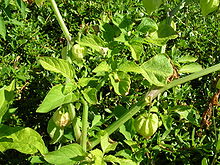- Physalis angulata
-
Physalis angulata 
Cutleaf groundcherry Scientific classification Kingdom: Plantae (unranked): Angiosperms (unranked): Eudicots (unranked): Asterids Order: Solanales Family: Solanaceae Genus: Physalis Species: P. angulata Binomial name Physalis angulata
L.Physalis angulata is a widely-distributed herbaceous annual plant with common name of Fisalia, belonging to the nightshade family Solanaceae. It is known by several names, including Cutleaf groundcherry, Wild tomato, Camapu and Winter cherry. The plant has perennial habits and is reproduced by seeds, its leaves are dark green and roughly oval, often with tooth shapes around the edge. The flowers are five sided and pale yellow, whist the yellow-orange fruits, which are edible, are born inside a balloon-like calix. They are similar in size, shape and structure to a tomato, but partly or completely surrounded by a large shell which derives from the whorl. Its tree can reach up to 6 feet high, approximately (2 meters).
The genus Physalis stands out in the Solanaceae family for having a swollen and vesicular fruitful cup that continues to develop after fecundation, involving the fruit completely. The origin of the name Physalis is due to the characteristics aforementioned, since Physalis means bladder, in Greek. The species has naturalized in Australia, but in the Northern Territory its arrival is thought to pre-date European settlement, so it is considered native there. In Colombia, is known as Uchuva, in Japan as Hosuki and in Azores as tomate capucho (tomato hood). Colombia is the world's leading producer and supplies the European market, mainly Germany and Holland. The Physalis is native to temperate, warm and subtropical regions throughout the world.
See also
- Physalis
- List of Brazilian fruits
 Media related to Physalis angulata at Wikimedia Commons
Media related to Physalis angulata at Wikimedia Commons
This Solanales article is a stub. You can help Wikipedia by expanding it.
